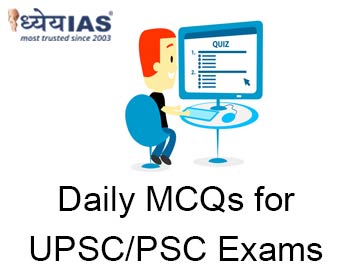Home > Daily-mcqs
Daily-mcqs 21 Feb 2025

Q1:
Consider the following statements: 1. The Indian government recently introduced the Peatland Conservation and Restoration Act, 2025, to improve peatland protection. 2. Peatlands cover around 10% of the world’s land surface. 3. Peatlands play a significant role in carbon sequestration, storing more carbon than all of the world’s forests combined. How many statements are correct?
A: Only 1
B: Only 2
C: All three
D: None of these
Answer: A
Explanation:
Statement 1: Incorrect. There is no Peatland Conservation and Restoration Act, 2025, introduced recently.
Statement 2: Incorrect. Peatlands cover about 3% of the world’s land surface, not 10%.
Statement 3: Correct. Peatlands are the largest terrestrial carbon stores, holding more carbon than all of the world’s forests combined.
Q2:
Consider the following statements: 1. Peatlands store more carbon than all the world’s forests combined. 2. According to a recent study, 27% of the world’s peatlands are located on indigenous peoples’ lands. 3. Peatlands are the second most protected ecosystem, after mangroves. How many statements are correct?
A: Only 1
B: Only 2
C: All three
D: None of these
Answer: B
Explanation:
Statement 1: Correct. Peatlands store more carbon than all of the world's forests combined.
Statement 2: Correct. 27% of the world’s peatlands are located on indigenous peoples’ lands, where these communities have protected them.
Statement 3: Incorrect. Peatlands are less protected compared to other ecosystems like mangroves (42% protected), salt marshes (50% protected), and tropical forests (38% protected).
Q3:
Consider the following statements regarding India's new draft regulations on predatory pricing: 1. The Draft Competition Commission of India (Determination of Cost of Production) Regulations, 2025, aim to update the methodology for determining production costs in predatory pricing cases. 2. The 2025 draft regulations propose to replace the existing CCI (Determination of Cost of Production) Regulations, 2009. 3. The consultation period for stakeholders is open from January 1 to March 31, 2025. 4. The primary objective of the regulations is to regulate predatory pricing and ensure fair competition in India’s markets. How many statements are correct?
A: Only 1
B: Only 2
C: Only 3
D: All four
Answer: C
Explanation:
Statement 1: Correct. The proposed regulations aim to update the methodology for determining production costs in predatory pricing cases.
Statement 2: Correct. The draft regulations will replace the existing 2009 regulations.
Statement 3: Incorrect. The consultation period is open from February 17 to March 19, 2025, not from January 1 to March 31.
Statement 4: Correct. The regulations aim to regulate predatory pricing and ensure fair competition in India’s markets.
Q4:
What is the IUCN status of the African Cheetah?
A: Critically Endangered
B: Vulnerable
C: Endangered
D: Least Concern
Answer: B
Explanation:
According to the table, the African Cheetah is listed as "Vulnerable" on the IUCN Red List. However, it's worth noting that scientists are demanding an update to "Endangered" due to declining populations.
Q5:
Consider the following statements regarding Project Cheetah: 1. Project Cheetah is an initiative by the Government of India to reintroduce cheetahs, which went extinct in India in 1952. 2. The project began in 2020 with cheetahs arriving from South Africa. 3. One of the goals of Project Cheetah is to promote tourism and restore ecological balance in the areas where cheetahs are being reintroduced. Which of the above statements are correct?
A: Only 1
B: 1 and 3
C: All three
D: Only 3
Answer: B
Explanation:
Statement 1: Correct. Project Cheetah is an initiative to reintroduce cheetahs, extinct in India since 1952, by importing them from Africa.
Statement 2: Incorrect. The project began in 2022, not 2020, with cheetahs arriving from Namibia.
Statement 3: Correct. One of the primary goals of Project Cheetah is to restore ecological balance and promote tourism in the areas where the cheetahs are released.